What do you do when you have a question or want to find something? Quickly.
If you’re like most, you open your laptop or unlock your phone, pull up a web browser, and head for the search bar. Once you say or type a few words and hit “enter,” you browse the results until you click on a page that looks promising. After the page loads, lo and behold: the answer you need.
The words you type into search engines play a role in how easily you find a blog or web page- and the same goes for the way people find your website. If you want people to find your website, you must understand what keywords are, why they matter, and best practices for how to find them. In this post, you will learn how to do so successfully and strengthen your content strategy on your own (search) terms.
Navigate to what you need to know first about keywords:
Considerations for Choosing a Keyword
How many keywords should I use?
How to Find Keywords the Right Way
How to Create Unique Content Through Niche Keywords
For instance, if you were to type “bikes” into a search engine, the results would show a variety of results that correlate with those keywords:
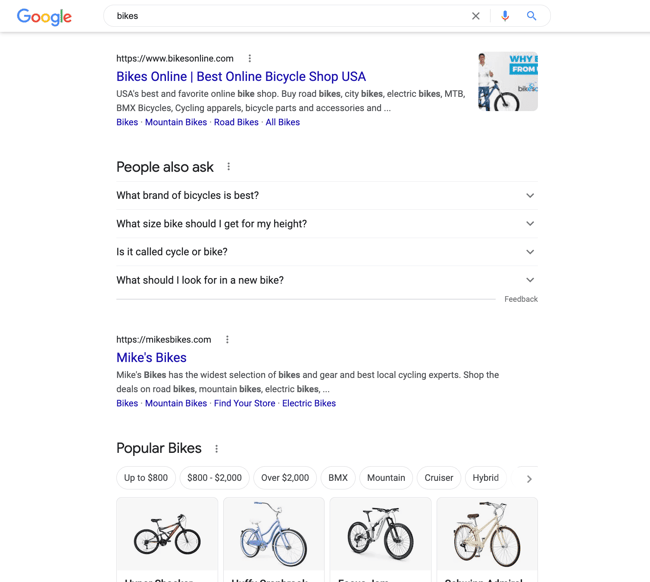
Here, the term “bikes” is an example of a short keyword; you can count on keyword lengths to fall into two categories:
- Short keywords that contain one or two terms
- Long-tail keywords that contain typically three or more terms
As a result, short keywords are generally on broad topics, while long-tail keywords are all about specificity. Take a look at what a long-tail version of “bikes” would look like if you search “mountain bikes for beginners”:
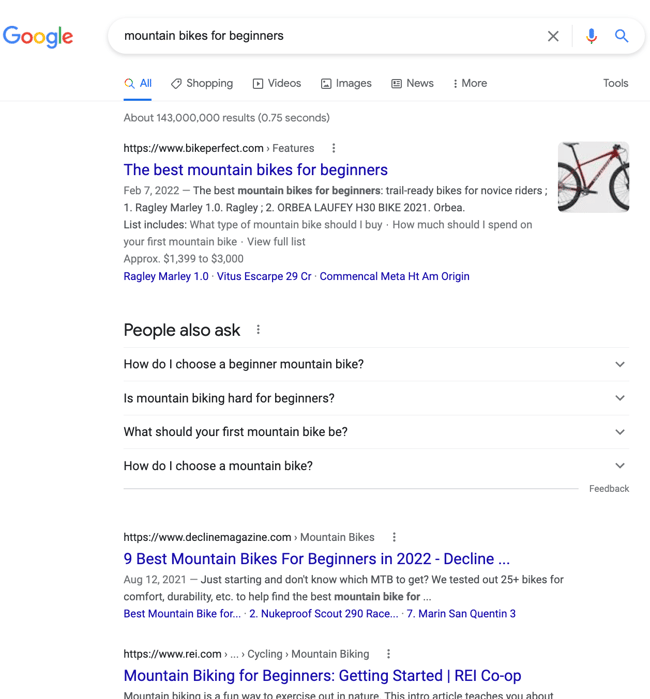
Therefore, understanding which type of keywords to use on your website or blog requires performing some investigation. As you begin your keyword research, you will start to discern the difference between picking a related keyword and writing for a user’s intent.
The 3 Common Types of Search Intent
Behind every keyword is the reason the user makes the search query in the first place. This is known as search intent which falls into 3 categories: informational, navigational, and transactional.
Take a look at your keyword and think about what the user is really asking by making their query:
- If they were to search, “what are nfts” they are feasibly looking for informational content that will explain this topic in detail.
- If they look up “nft marketplace” they are likely searching for navigational content to take them to NFT platforms.
- If they type “best nfts to buy now” they are probably trying to find transactional content that will help them complete a purchase decision.
By speaking to the “why” of the search query, you can tailor each content page to fully provide value to the user and deliver the best possible experience. But to fully grasp how to provide this value, you need to know the impact of keywords and why they matter to your website in the first place.
Now, while keywords are still useful tools for conceptualizing and planning your content strategy, their effectiveness is entirely rooted in context.
For instance, say you’ve written SEO blogs about the various aspects of software. If you have been fleshing out a topic cluster to demonstrate your content authority, Google will have the context it needs when ranking websites like yours.
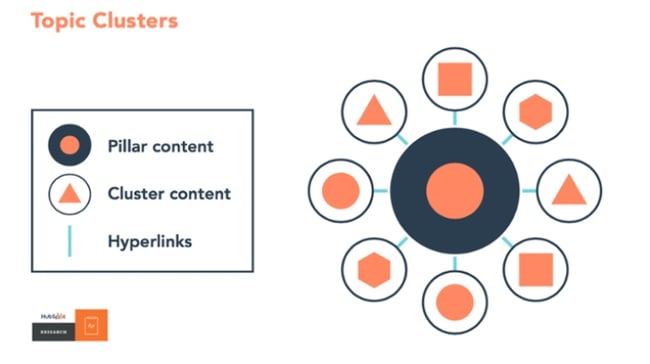
The keywords you include on your pillar and cluster pages will guide you to produce content on a range of user interests. But with the paradox of choice, how do you choose a good keyword? Your decision will depend on the marketing channel you’re writing for and your short or long-term goals.
Let’s dive into how to define good keywords across SEO and PPC channels to put you in the best position to benefit from your content.
What are good keywords?
What qualifies as a good keyword in SEO is different from what makes for the right target in PPC. But how do SEO keywords differ from keywords for PPC on the SERP?
Understanding this difference takes learning how to use SEO and PPC keywords to your website’s advantage.
Using Keywords in SEO
A good SEO keyword strikes the ideal balance between keyword volume, competition, relevance, and intent based on your website’s authority. Therefore, adding keywords that encompass these factors, will allow you to rank and drive traffic long-term.
Plus, because SEO keywords are free- to rank for and when users click on your content- you can receive high value from the content you produce.
While the roster ranges both on and off the page, SEO content includes:
- Blogs
- Articles
- Website copy
- Metadata like title tags or meta descriptions
Unlike the other forms, the keywords in metadata aren’t ranking factors. But best practices are to include your targeted keyword in the title tag and description. Take a look at how metadata appears on the SERP with the title tags outlined in red and descriptions in blue below: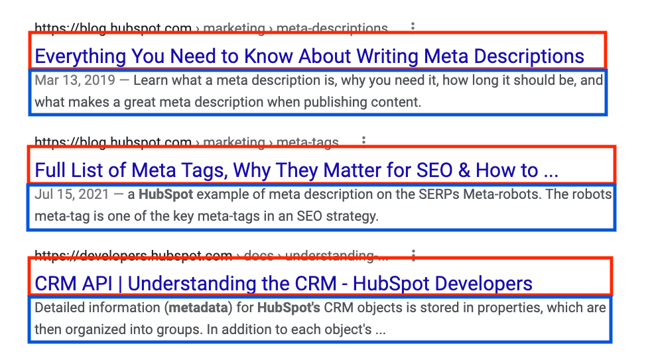 What’s special about finding the right keywords, is that it allows you to write rich content around what people are interested in and satisfy Google’s E.A.T. principle — a major Google core update from 2019. Your keywords will be your guide to writing a piece that meets a search engine like Google’s expectations of:
What’s special about finding the right keywords, is that it allows you to write rich content around what people are interested in and satisfy Google’s E.A.T. principle — a major Google core update from 2019. Your keywords will be your guide to writing a piece that meets a search engine like Google’s expectations of:
- Expertise
- Authoritativeness
- Trustworthiness
So before you dive into finding keywords, start by thinking about the topics that matter to your website. What are some things your audience may be searching for that would lead them to you? Have some ideas in mind? Start there.
Using Keywords in PPC
On the other side of Search are PPC keywords. PPC keywords are terms you choose to rank for in order to increase brand visibility and foster website growth. You can bid on your keyword choices, and when you win your bids, you will rank at the top of the SERP like these businesses below:
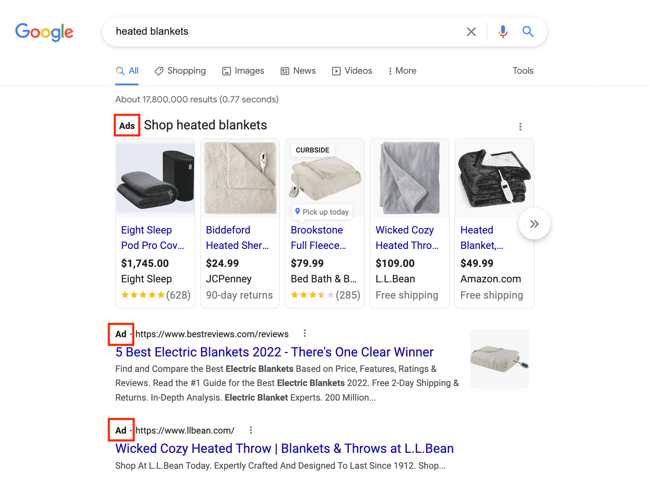
So, you can use keywords to create PPC ads promoting your products or services through platforms like Google Ads and Microsoft Ads. Then, when users select your ad, you pay for every click you receive.
Now, there are two main types of PPC keywords:
- Branded keywords are words and phrases that include your brand’s name. Their purpose is to attract customers in your audience that are near a purchase decision.
- Non-branded keywords are words or phrases that do not include your brand name. They help you gain new customers who may be searching for what you offer but do not know it yet.
Essentially, pay-per-click advertising generates immediate traffic that can convert into leads or sales. Subsequently, these conversions deliver a faster return on investment for the money and time you put into your ads. You will use PPC keywords to tailor your content to the audiences you decide to target.
When it comes down to when to apply SEO versus PPC advertising, it depends on your business goals. Will your business benefit from the long-term impact of Organic Search or the short-term results of Paid Search? While you contemplate this, remember SEO content concentrates on providing value to the reader, while PPC content focuses on promoting your products or services.
Still, the tricky part is that the internet is a busy place — making it virtually impossible to be the only person writing about any given topic. So even if you create rich content with keywords and provide the context for search engines to understand it, how do you stand out from the crowd?
Well, this is where the following keyword considerations come into play.
Considerations for Choosing a Keyword
Monthly Search Volume
Monthly search volume (MSV) is the number of times people search for a particular keyword in a month. By considering the popularity of a keyword, you can tailor your content strategy and write about new content opportunities.
To find out how many people are searching for a particular keyword, you can use keyword research tools like the one below from Ahrefs. For instance, when you type in the word “insurance” the tool provides the following MSV estimate outlined in red:
Oftentimes, competitive keywords with higher difficulties are the ones in which everyone in an industry wants to rank. For example, broad keywords like “insurance,” “marketing,” or “technology” are all going to be highly competitive because they have a high volume of monthly searches. There is also a bevy of written content on these topics vying for a keyword ranking.
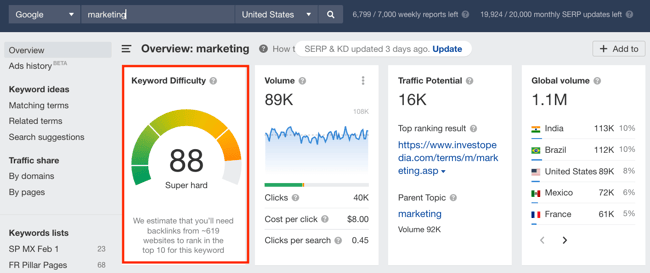 The market for these and similar broad search terms is completely saturated. So getting a foothold for a search term like “marketing” would be like constructing a generic coffee shop between a Starbucks and a Dunkin’ Donuts — you may get a bit of business if a customer notices you in your area, but they’re more likely going to go to one of the established businesses they know.
The market for these and similar broad search terms is completely saturated. So getting a foothold for a search term like “marketing” would be like constructing a generic coffee shop between a Starbucks and a Dunkin’ Donuts — you may get a bit of business if a customer notices you in your area, but they’re more likely going to go to one of the established businesses they know.
For your business to truly gain SEO ranking, it’s important to consider less competitive keywords. Focusing on less keyword competition lets you demonstrate what makes you different and reach the best audience for your business.
If we return to our coffee shop example, concentrating on less competitive keywords is like branding yourself as the only ‘specialty cat cafe’ in the city. In this situation, it’s easier to stand out because you’re focusing on what makes you unique to your target buyer persona.
After all, the person looking for a cat cafe to sit in and relax is probably not the same person wanting a quick cup of coffee on their way to work — just like someone searching for “technology” is not the same person searching for “small business technology setup service.”
Intent & Relevance
We’ve established that search intent is the “why” behind the terms users search, but did you know that search engines use this intent to rank content? This relationship is called keyword relevance: how closely related a keyword or phrase is to a piece of content.
For example, say you own a website about baking and you want to target the keyword “easy cake recipes” in your content. But instead of writing a thorough article on these recipes, you write more about the history of cake. Even though this article may be intriguing, it’s not relevant to your primary keyword— and you’re unlikely to rank for your target. So be sure to keep keyword intent and relevance top of mind as you research.
How many keywords should I use?
It’s a question that has withstood the tests of time (spent on digital marketing): what are the optimal number of keywords for SEO content?
Well, for a long time digital marketers organized their entire content calendar around specific keywords — and the number of times to include these keywords on the page. They’d work with their teams to brainstorm focus keywords relevant to their products or services using keyword research tools. Then analyze all the variations of that keyword most likely to be a source of website traffic.
Unfortunately, as time went on, publications began keyword stuffing; publishing irrelevant, poorly-written content with specific keywords just to drive traffic. Eventually, search engines — largely led by Google, and the constantly-changing Google search algorithm — became more advanced. Instead, a more contextual-based approach to digital content was favored over simply keyword count.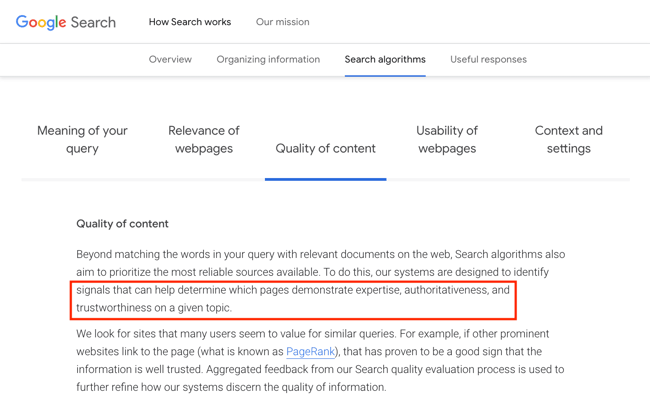 So as the power of keywords continues to shift, so does the importance of how often you use them. Yet, deciding how many keywords you should use is
So as the power of keywords continues to shift, so does the importance of how often you use them. Yet, deciding how many keywords you should use is
still worth the consideration because it is a matter of keyword density: the ratio of keywords on your page versus the overall word count of the piece.
Aside from using a formula to calculate this ratio, you can also conduct a competitive analysis to examine the keyword density for specific keywords your competitors target.
There’s no magic trick to how to get on the first page of Google when it comes to SEO. To rank well on search engines, you need to consistently create rich SEO content and think about how it fits together in the long term. You must also be clear about your content strategy and the keywords you use to guide it.
Leveraging keywords to build your content foundation enriches your content marketing strategy and teaches you how to get traffic to your website — now, we’re going to tell you how to find them.
 1. Clearly define your target buyer persona.
1. Clearly define your target buyer persona.
Having a clear understanding of your ideal audience is the key to any marketing endeavor. With keyword research, you must understand what questions you can answer or problems you can solve for this target buyer persona. At this point, it’s okay to think in broad search terms regarding what those problems or questions are.

For instance, if you’re a PR agency, you need to find leads who are interested in hiring a third party to help them run a PR campaign. To do this, perhaps you begin by writing digital content that answers the question “How to run a successful PR campaign”.
A broader content topic is a good starting point for building a pillar page for your topic cluster.
2. Narrow your focus and investigate keyword competition.
Once you determine the overarching question or problem to address, it’s time to get more specific. Getting more specific allows you to cater your content to your target audience, and it helps you leverage less competitive keywords.
I like to narrow my focus keyword by using lsigraph.com. LSI, or latent semantic indexing, is a process of generating search query variations by determining how closely a given search term relates to other search terms. Think of latent semantic indexing tools as a way of brainstorming and generating a lot of keyword ideas quickly and easily.
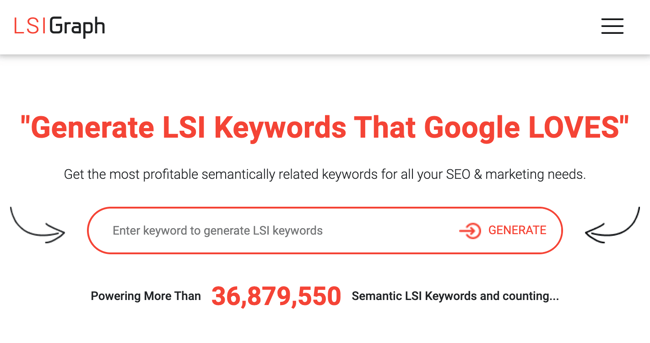
From there, use keyword tools like Google’s Keyword Planner to analyze a competitive keyword. This analysis allows you to determine which keywords have the most potential for your business.
3. Collect data, analyze keyword research results, and repeat.
As you create content around specific keywords, keep in mind that a great content strategist doesn’t just throw content out randomly to see what sticks. Consider using a tool like Google Search Console to track how your website is performing for your keywords.
Google Search Console can also help you see whether your traffic is increasing from keywords you hadn’t planned on ranking for and this informs your future digital content strategy. Having this knowledge is crucial to further refining your keyword planning and identifying content gaps that have significant potential to bring you new customers.
How to Create Unique Content Through Niche Keywords
What’s great about leaning into less competitive keywords is that it will allow you to build your brand authority within a specific field through clearly defined niche content. Niche content is a specialized writing topic that engages a specific audience’s interests to make a viable impact in your industry’s content market.
If we reexamine our “marketing” example above, we see how difficult it is to make an impact by writing general content on “marketing” in such a saturated market. But what if your content targets a longer, more specific keyphrase like “marketing portfolio examples” and an audience of marketers trying to build or bolster their marketing portfolio?
.png?width=650&name=writing-niche-content%20(1).png) As you can see, although the monthly search volume for this keyword is significantly lower, it would be easier for you to get a foothold in the market thanks to this phrase’s lower keyword difficulty. To become more authoritative in your space, you need to incorporate long-tail keywords into your content strategy.
As you can see, although the monthly search volume for this keyword is significantly lower, it would be easier for you to get a foothold in the market thanks to this phrase’s lower keyword difficulty. To become more authoritative in your space, you need to incorporate long-tail keywords into your content strategy.
Because these keywords have less SEO competition, it’s easier to establish yourself as a content authority on a given subject — which is invaluable in SEO.
Whether you’re just getting started with keyword planning or looking to amplify your current content efforts, keep your customer persona at the front of your mind, and don’t be afraid to recalibrate your content strategy as you collect more data. Great inbound marketing is about having the right content reach your ideal potential customers when they need it, and getting smart with your keyword approach is a fantastic way to do that.
Editor’s note: This post was originally published in April 2019 and has been updated for comprehensiveness.
![]()
Source: Hubspot
Please rate this post

With over 20 years of experience in the car business, I’ve navigated the evolution of the industry from traditional sales to the dynamic digital age. My journey through various roles in both sales and management has endowed me with a unique perspective on the challenges and opportunities in automotive sales today.
As the founder of Shawn Ryder Digital, I combine my extensive background in technology with my deep understanding of the automotive industry. This synergy allows me to craft digital marketing strategies that are not just effective but tailored to the specific needs of each dealership. My commitment is to drive your sales, enhance your brand awareness, and ensure your dealership thrives in the digital landscape.
Here at Shawn Ryder Digital, we’re not just about providing services; we’re about building partnerships. As I often say, “In the fast-paced world of digital marketing, staying ahead isn’t just an option; it’s a necessity.”
Together, let’s embrace the challenges of the digital age and turn them into opportunities for growth and success. Join me in redefining the future of automotive digital marketing. Let’s accelerate your dealership’s journey to the top.

